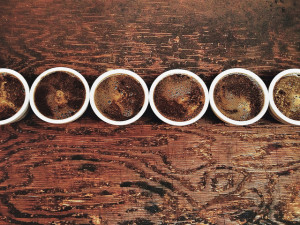Keith Hautala operated the Magic Beans micro-roastery and coffeehouse from 1999-2001. He and his partner, Schuyler Warren, started a new coffee-roasting venture in 2012 and named it Magic Beans Coffee Roasters as a tribute to the original. Keith also maintains a full-time job in public relations. He lives in Lexington with his wife, Melinda, and their three dogs.
I first came to Lexington, Kentucky, in 1998. As a Berkeley boy, I had grown up around good coffee and had come to take it for granted. I was surprised to find there wasn’t a decent cup to be had in this relatively affluent, medium-size city, which is home to the state’s largest university. There was but one coffeehouse anywhere near campus, and it was constantly busy. A popular hangout for the under-21 crowd, the main attraction was clearly not the coffee, which tasted like warm water that had been left to soak in a dirty airpot.
Sensing an opportunity to do well by doing better, I decided to open Lexington’s first micro-roastery coffeehouse, specializing in high-quality, single-origin coffees. How could it fail? One sip of the good stuff, and Lexington would never turn back. So, with a used Sivetz five-pound electric roaster (purchased from an ad on Usenet), and some generous backing from a friend on the West Coast, I opened Magic Beans in June of 1999. I set up shop right next to a popular lunch spot, in a converted tobacco warehouse near campus. On the first day, I did $40 in sales, in just 14 hours. After a week, I had amassed nearly $400.
There was resistance, even resentment, from some first-time customers. One woman placed a flyer gently on the counter and told me, in a tone meant to convey helpfulness, “You should probably know that a lot of people are going to find this offensive.” I was stunned. The flyer said something about Magic Beans having “The Only REAL Coffee in Town!” A little advertising hyperbole. Harmless. The customer advised me that you don’t make friends by telling people how much better you are: “People are going to take this like you’re calling them stupid.”
She was right.
Breaking into the market in Lexington was a struggle. For starters, coffee was not something people were accustomed to going out of their way for, let alone spending real money on. I was not at all prepared for the type of questions I got at the beginning.
“A dollar-fifty? For coffee? I can get that for 69 cents at the gas station!”
“What’s your flavor of the day?”
“Why no free refills?”
Teaching customers is a tricky business. You want them to like you and to give you their money. But it’s a universal fact that people don’t like to be confronted with their own ignorance, and they hate to be told “No.” They have been taught that the customer is always right. Yet there you are, disappointing their expectations, and refusing to sell them what they want on their terms. They don’t know what a “micro-roaster” is, or why anybody would bother to roast coffee in the first place. The words “single origin” mean nothing to them. They don’t get it. They don’t get you. So they walk away.
And a lot of people did walk away. Sometimes, I even encouraged it. Once, a newcomer asked, “What do you have for people who don’t like coffee?” In a moment of glibness (which I have long since come to regret), I responded with: “Clearly marked exits.” What I should have said was: “Coffee like you’ve never tasted it before.”
 In spite of my arrogance and bad attitude, I managed to recruit a cadre of regulars who developed a real interest in coffee. They asked a lot of questions. It was as if I was selling a brand-new product that they had never seen before. In a sense, I was. I came to expect that there would be a five-minute interview before I would be able to sell somebody a latte or a bag of beans. Eventually, I learned to give customers only the information they really wanted, and not to overwhelm them with details.
In spite of my arrogance and bad attitude, I managed to recruit a cadre of regulars who developed a real interest in coffee. They asked a lot of questions. It was as if I was selling a brand-new product that they had never seen before. In a sense, I was. I came to expect that there would be a five-minute interview before I would be able to sell somebody a latte or a bag of beans. Eventually, I learned to give customers only the information they really wanted, and not to overwhelm them with details.
For example, when a new customer asks, “What’s the difference between Sumatra and Guatemala?” she is probably not looking for a half-hour lecture on differences in geography or processing techniques. She may or may not know that both of those names refer to the places where the coffee is actually grown. Most likely, she just wants to know which one she might like better. After giving a few dozen lectures on differences in geography and processing techniques, to mostly baffled responses, I discovered that this is the type of question that is best answered with another question: “Would you like to try them both?” (Almost nobody ever refuses free samples.)
While the customer would taste the coffees, I would introduce a little bit of vocabulary and perhaps contrast a few components of flavor and aroma. I might talk a little about different roast profiles. Ideally, the whole presentation would take no more than about 45 seconds. With repeat visits, customer questions became more advanced — and more challenging to answer.
“What’s a semi-washed coffee?”
“What’s the difference between ‘natural’ and ‘pulp natural’?”
“Do you think convection heat is better for roasting coffee than conduction?
Sometimes the customers would stump me, in which case I would have to answer, “I don’t know. I’ll have to look into that.” The great thing about intellectual curiosity is that it’s contagious, and it tends not to ever be satisfied. Rather, it feeds itself and becomes larger. Questions lead to more questions, and increased knowledge translates to enthusiasm. One customer brought in a copy of Michael Sivetz’s authoritative text, Coffee Technology, on a 60-day loan from the university library. Others brought in articles they had run across in various newspapers, magazines and journals. We were learning together and sharing resources. The coffeehouse became a group project.
Educating customers is hard work, especially in a virgin market. It requires patience and tact. The rewards are not always immediately apparent. Still, you will know you’ve done a good job when you’re standing behind the counter and you see one of your customers talking to somebody you’ve never seen before, telling them all about the different origins, the roasting process, and the importance of good water and a proper grind.
And all you have to do is stand back, take a sip of coffee, and smile.
Keith Hautala
Keith Hautala operated the Magic Beans micro-roastery and coffeehouse from 1999-2001. He and his partner, Schuyler Warren, started a new coffee-roasting venture in 2012 and named it Magic Beans Coffee Roasters as a tribute to the original. Keith also maintains a full-time job in public relations. He lives in Lexington with his wife, Melinda, and their three dogs.







Comment